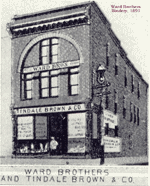Early Years / Start of Prebinding / Binding Standards / Second Generation / End of Rebinding / Growth of School Libraries / Turn of the Century
Early Years

Early Years
Lawrence D. Sibert (1891-1979) began working for Ward Brothers, a printing and bookbinding company in Jacksonville, Illinois in 1908. He learned the trade of bookbinding and was a department foreman by 1913.
In January 1920, Sibert started a libary bindery known as New Method Book Bindery with William T. Suhy in Jacksonville. The two men were brothers-in-law. Suhy was the salesman who called on libraries thoughout the Midwest while Sibert ran the bindery. The company had three employees.
Also in 1920, W. Elmo Reavis, a prominent California bookbinder, invented the oversewing machine. This machine was a vast improvement over the difficult, tedious hand sewing and gave impetus to the growth of this new specialized bookbinder, the library binder. These new companies rebound worn library books and also bound together volumes of magazines. Public libraries were being built and existing libraries were expanding greatly during the first few decades of the twentieth century resulting in a growing demand for the services of the library binders.
New Method Book Bindery did fairly well and by 1923 the business moved from the second floor of Degan's dance Hall at 220 South Main to the three-story Brown's Business College building at 201 South Kosciusko. At the new location, boxes of finished books were lowered by a lift from the second floor to the ground for shipment. One day the lift broke and a load of books fell to the ground. Only one corner of one book was damaged and a bystander remarked, "Those books are certainly bound to stay bound!" Thus was the company slogan born.
In January 1920, Sibert started a libary bindery known as New Method Book Bindery with William T. Suhy in Jacksonville. The two men were brothers-in-law. Suhy was the salesman who called on libraries thoughout the Midwest while Sibert ran the bindery. The company had three employees.
Also in 1920, W. Elmo Reavis, a prominent California bookbinder, invented the oversewing machine. This machine was a vast improvement over the difficult, tedious hand sewing and gave impetus to the growth of this new specialized bookbinder, the library binder. These new companies rebound worn library books and also bound together volumes of magazines. Public libraries were being built and existing libraries were expanding greatly during the first few decades of the twentieth century resulting in a growing demand for the services of the library binders.
New Method Book Bindery did fairly well and by 1923 the business moved from the second floor of Degan's dance Hall at 220 South Main to the three-story Brown's Business College building at 201 South Kosciusko. At the new location, boxes of finished books were lowered by a lift from the second floor to the ground for shipment. One day the lift broke and a load of books fell to the ground. Only one corner of one book was damaged and a bystander remarked, "Those books are certainly bound to stay bound!" Thus was the company slogan born.

Loading...




